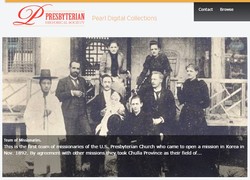Last fall, the Presbyterian Historical Society (PHS) launched its Pearl online archives. Ten months later, Pearl already features 5,000 virtual items to explore, including rare mission field photographs, foundational church records, and newly digitized audio recordings and motion pictures featuring the likes of Bill Bradley, Edler G. Hawkins, and Carl McIntire.
PHS, the National Archives of the Presbyterian Church (U.S.A.), saves historic Presbyterian documents, media, and artifacts from the ravages of time. Pearl saves time—and money—by providing researchers with virtual access to archival materials. All you need is an internet connection.
“Before Pearl you had to visit Philadelphia to interact with any of our items,” said Preservation Archivist Natalie Shilstut, who oversees the ingestion, or addition, of new items into Pearl. “Now you can digitally examine them up close from home or on the road.”
Recent additions to Pearl include Congo mission collections, abolitionist correspondence from antebellum Ohio, early 20th century church postcards, and films from the Civil Rights Movement. Using smartphones, school workstations, and personal computers, researchers can browse items, search specific historical themes, and save items in a “bookbag” list. Each item is accompanied by metadata giving descriptive, reproduction, and creator information.
“We ramped up planning for Pearl in 2014,” Shilstut said, “around the time we made the switch from microfilming to digitizing church records.” With financial support from the Otto Haas Charitable Trust and individual donors, and with technical support and server space from the PC(USA) Board of Pensions, the society established an Islandora digital asset management system that is easy to integrate with other open source tools. That flexibility allows Pearl to adjust to the quickly changing digital landscape.
Pearl’s Islandora server provides 3 terabytes of storage space—enough for 1,500 hours of movies; 50,000 hours of music; or 930,000 photos. The society’s scanning team digitizes and adds new items to Pearl each week. Scanning is done onsite in Philadelphia on flatbed scanners and a planetary scanner.
According to Shilstut, the most difficult item the society scanned in the last year is one of its most fragile: a field album of Eugene R. Kellersberger that includes photographs, medical notes, and sketches depicting sweeping African landscapes and small villages. Each of the item’s 300 pages is preserved in a Mylar sleeve.
“It would have been three times as fast to scan everything on our planetary scanner,” Shilstut said. “But we took the pages out to increase image quality.”
The online archives is named after Pearl S. Buck, a Presbyterian Church in the United States missionary to China and Nobel-Prize winning author. Many of her books, including The Good Earth, take place in Anhui Province, where she served from 1914 to 1933.
For more information about Pearl or digitizing church records at PHS, contact Natalie Shilstut at 215-928-3860.

